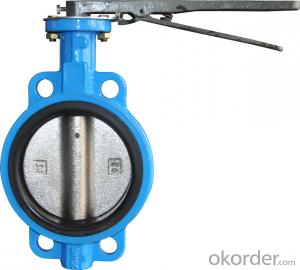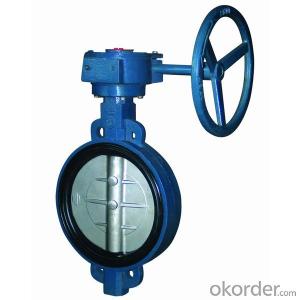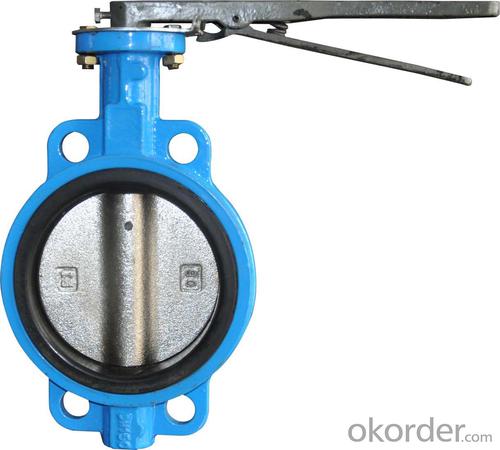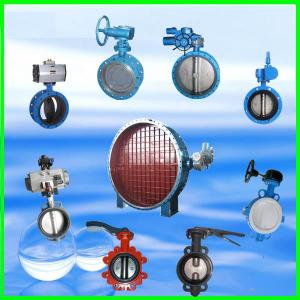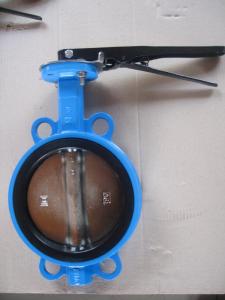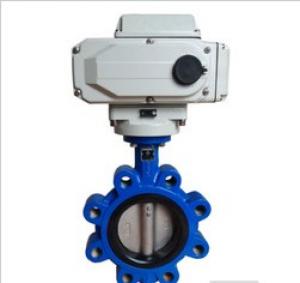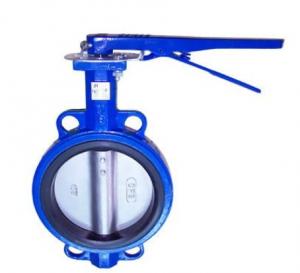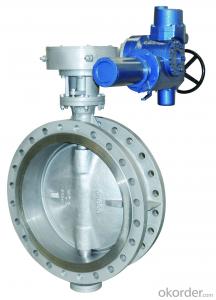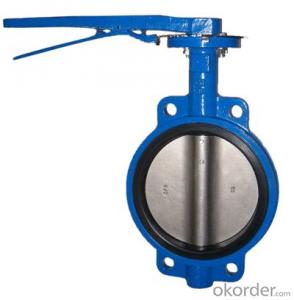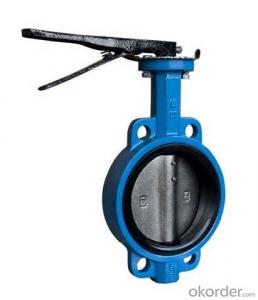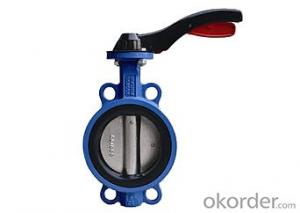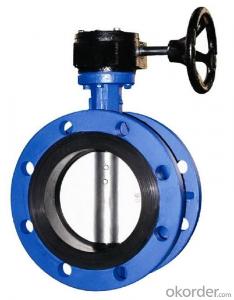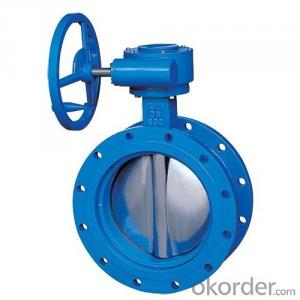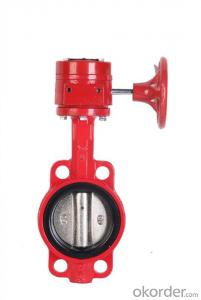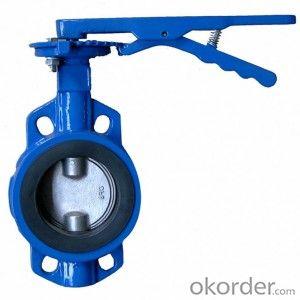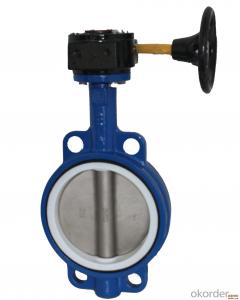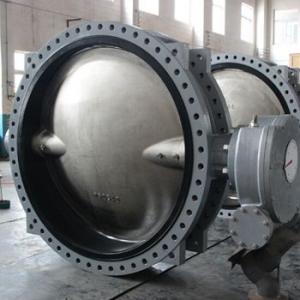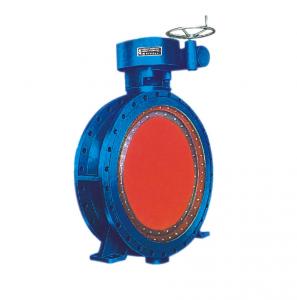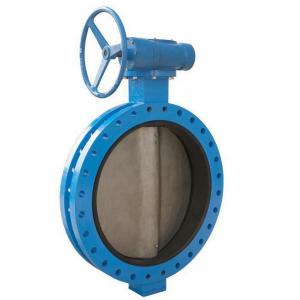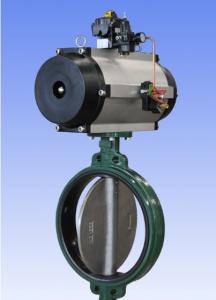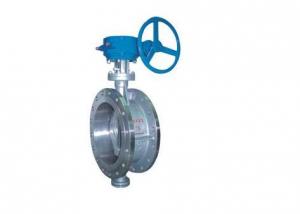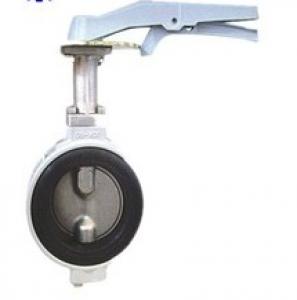Butterfly Valves Ductile Iron Wafer Type DN540
- Loading Port:
- China main port
- Payment Terms:
- TT OR LC
- Min Order Qty:
- 100 set
- Supply Capability:
- 80000 set/month
OKorder Service Pledge
OKorder Financial Service
You Might Also Like
1. Manual Wafer Butterfly Valve Description:
A butterfly valve is a valve which can be used for isolating or regulating flow. The closing mechanism takes the form of a disk. Operation is similar to that of a ball valve, which allows for quick shut off. Butterfly valves are generally favored because they are lower in cost to other valve designs as well as being lighter in weight, meaning less support is required.
2.Main Features of the Manual Wafer Butterfly Valve
a)Cast hole. Flange connection meet ANSI 125/150# DIN PN10/16 BS4504 PN10/16 in the meanwhile.
b)Soft seat. Replaceable. Increase of service life.
c)Double half shaft without pin.
d) Square and short neck. Easy to stick scutcheon and cost saving.
Design & Manufacture acc. to API 609,MSS SP-67,BS5155,BS EN593.
Face to Face acc. to DIN3202,API609,MSS SP-67,BS5155,BS EN558.
Top Flange acc. to ISO5211.
Pressure test acc. to API598,BS EN12266-1,DIN3230,BS5155.
Side Flange acc. to DIN2501,ANSI125/150,AS2129,BS4504,BS10D&E,JIS10K
3. Manual Wafer Butterfly Valve Images:
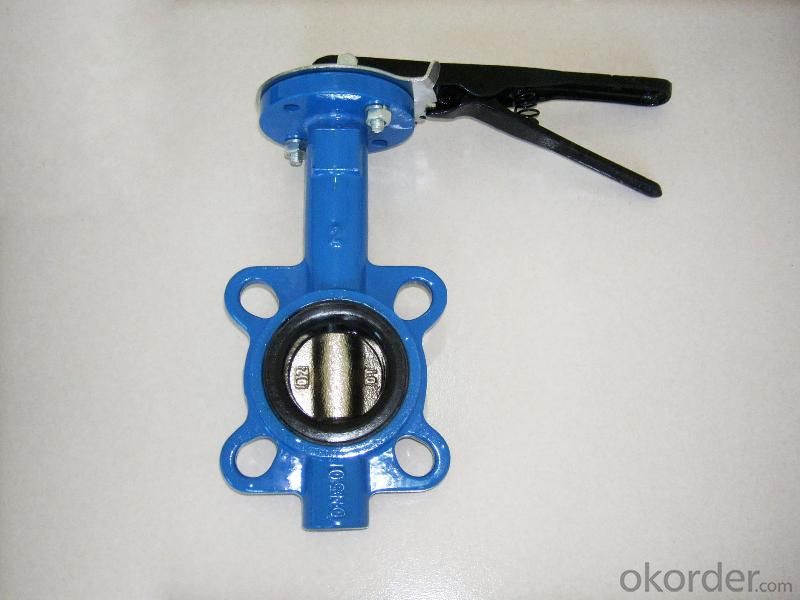
4.Manual Wafer Butterfly Valve Specification:
Size: | DN50-DN1000 |
End flange: | ANSI B 16.1,EN1092,AS2129 |
Face to face: | ANSI B 16.10 |
Top flange: | ISO 5211 |
Normal pressure: | PN1.0/1.6MPa(150/200PSI) |
Body: | CI/DI/WCB/ALB/CF8/CF8M |
Disc: | DI/ALB/Rubber lined Disc/1.2501/1.4529/CF8/Hastelloy Alloy/Monel |
Stem: | 410/416/304/431/17-4PH/316/monel |
Seat: | NBR/Hypalon/EPDM/Neoprene/NR/Wear-Resistant EPDM/Viton/Silicon/Heat-Resistant EPDM/White EPDM/EPDM(NSF)/PTFE |
Suitable temperature: | -10~120 |
Medium: | Fresh water, sewage, sea water, air, vapor, food, medicine, oils, alkalis, salt etc. |
Nominal Pressure: PN10/PN16
Working Temperature : -45 C centigrade-+200C centigrade
Suitable Mediums : Fresh water, Sewage, Sea water, Air, Oils, Acids, Alkalis, Salts, etc.
5.FAQ
1. How about the Installation of the Wafer Style Butterfly Valve?
A: Butterfly valves are installed by inserting the valve between two flanges using bolts or studs and nuts to hold it all together. This type of installation, of course, makes it impossible to disconnect just one side of the piping system from the valve. That benefit is received using the lug style valve.
2. What is the working principle of manual wafer butterfly valve?
A: A butterfly valve is from a family of valves called quarter-turn valves. In operation, the valve is fully open or closed when the disc is rotated a quarter turn. The "butterfly" is a metal disc mounted on a rod. When the valve is closed, the disc is turned so that it completely blocks off the passageway. When the valve is fully open, the disc is rotated a quarter turn so that it allows an almost unrestricted passage of the fluid. The valve may also be opened incrementally to throttle flow.
- Q: Electric butterfly valve (not take the lead) what do you mean?
- Electric butterfly valve, as its name implies, consists of an electric actuator and butterfly valve, and the customer does not take the lead, that is, without the electric actuator, only the butterfly valve can be provided.
- Q: My caravan is a bit sluggish on the pick up, I replaced the wires/plugs and the electronic distributor(I think thats what it is..). still a bit sluggish. Should i look at the valve gasket? Or fuel filter, or fuel pump next? 03 caravan sport 3.3L
- the valve pan gasket won,t cause it but the fuel filter will if it,s starting to clog up and also the cat nverter !
- Q: Ok, so I took my car in for maintenance (Mustang GT convertible 2002) and the mechanic told me the valve gaskets needed to be replaced and when he gave me the estimate, they were two seperate charges for valve gaskets and valve covers, total of about $250.00 not including labor. Is he trying to rip me off cause I'm a girl by the way? Anyways, I didn't get it done cause it needed something else too and I didn't have enough money so I said I would be back in two weeks. So I called the dealership to inquire about the price and I asked the parts guy for a price on valve gaskets and he was like, I don't know what you mean, we have valve cover gaskets but nothing says just valve gaskets? I told him to give me the price anyways, thinking I would ask my brother (who hasn't tried to help me anyways) and it was $60.00 for both (I need two). How can this be if the other guy was charging me $250.00 for different parts? Help!!! Frustrated and confused, I don't know anything about cars :(
- here okorder /... usually you can tell when a car needs the gasket to be replaced because it will leak oil where the gasket is at the bottom of the cover i think hes ripping you off because cars usually dont need to have the valve cover replaced, just the gaskets so take it to another mechanic and get another estimate
- Q: Check valve; flexible joint `; installation order of electric butterfly valve
- Connect the Songjiang rubber joint from the pump outlet. Check the 1 valve
- Q: The water supply pipe is the gate valve And on the cross dry pipe are the gate valve? To answer the 30
- Crown valve pressThere is no standard answer to this question. I can only give you my personal opinionRiser butterfly valve is generally place in these places (the pump outlet valve, drainage system, upper and lower floors) riser are basically installed butterfly valve, butterfly valve is not cheap, fast speed is fast closing butterfly valve can be quickly closed and open educationYou see the water pipe installed valve (with all the cross tube is the basic gate) explanation, because in contrast to the quality and stability, the valve will be better, the site does not need fast switching, it will choose good stability point gateSum upThe drains are all butterfly valves, and the stabilizing pipes are all valves! (do not rule out a full use butterfly valve for stealing work)
- Q: What kinds of butterfly valves are available? What is the working principle of butterfly valves?
- At work temperature:(1) high temperature. T>450 degrees C butterfly valve.(2) medium temperature butterfly valve. 120 C<t<450 DEG butterfly valve.(3) normal temperature butterfly valve. A 40C<t<120 degree C butterfly valve.(4) low temperature butterfly valve. One 100<t< one, 40 degrees C butterfly valve.(5) ultra low temperature butterfly valve. T< one 100 degrees C butterfly valve. Www bgfm /df/Divided by connection:1 pairs of clip butterfly valveThe butterfly plate of the clip butterfly valve is installed in the direction of the diameter of the pipe. The valve is fully open.The clip butterfly valve is simple in structure, small in size and light in weight. Butterfly valve has an elastic seal and metal seal two types of seals. Resilient sealing valve. The sealing ring can be mounted on the valve body or attached to the periphery of the disc.2, flange butterfly valveThe flange butterfly valve is a vertical plate structure, and the stem is a sealing ring of an integral metal hard sealing valveFor flexible graphite plate and stainless steel plate composite structure, mounted on the valve body, butterfly plate sealing surface of stainless steel surfacing. The sealing ring of the soft sealing valve is made of nitrile rubber and is mounted on the butterfly plate.3, lug butterfly valve4 、 welded butterfly valveWelding type butterfly valve is a non sealed butterfly valve, widely used in medium temperature less than building materials, metallurgy and mining, electric power production process at 300 nominal pressure 0.1Mpa pipe, used to open and close connected, or adjust the medium quality.
- Q: What does butterfly valve do?
- 5, connections are flanged, wafer connections, welded connections and lugs on the clip connection. ?Drive in the form of manual, worm gear, electric, pneumatic, hydraulic, electro-hydraulic linkage actuator, can realize remote control and automation.Advantages of butterfly valves1, opening and closing convenient, fast and labor-saving, fluid resistance is small, you can often operate. ?2, simple structure, small volume, light weight. ?3, to transport slurry, accumulation of fluid in the pipe outlet at least. ?4, under low pressure, can achieve a good seal. ?5, good regulating performance.Disadvantages of butterfly valve1, use pressure and working temperature range is small. ?2, poor sealing. ?Butterfly structure can be divided according to the bias plate, vertical plate, inclined plate and lever type. According to the form of sealing can be divided into soft sealing type and hard sealing type of two. The soft sealing type usually adopts rubber ring seal, and the hard sealing type usually adopts metal ring seal. ?By connection type can be divided into flange and clamp connections; press can be divided into manual transmission, gear transmission, pneumatic, hydraulic and electric types.
- Q: Butterfly valve model D373F-16C, ask God answers
- D butterfly valve, 3 turbo rotating, 7 pairs clip type, 3 eccentric F PTFE seal, 16 nominal pressure 1.6MPA, C valve body material, carbon steel
- Q: The difference between the directly buried gate and the flange valve and butterfly valve
- Buried gate also called buried gate valve, valve can be directly buried underground, built without manhole, reduce road excavation area; small well maintained road and beautiful room can reduce the difficulty of construction, reduce project cost. The directly buried soft sealing gate valve is divided into two types: telescopic type and fine fixing type, wherein, the telescopic type is divided into metal type and plastic type. In the process of construction, the telescopic type can be adjusted arbitrarily according to the distance between the buried depth of the valve and the ground, and the micro adjustment can be adjusted on the spot. The directly buried gate valve has the advantages of long-term use, no leakage, no maintenance, etc., and can effectively avoid other people switching the valve and stealing the manhole cover at will.Flange gate valve is connected to the flange gate valve, this connection is the most common way. The flange gate valve is stable and reliable when used in the pipeline, so the flange gate valve is used on the high pressure pipeline.Butterfly valve refers to the closure of parts (valve or butterfly plate) as the disk, around the valve shaft to achieve rotation and closing of a valve, the main cut off on the pipe and throttling role. Butterfly valve headstock is a disc shaped disc, in the valve body around its own axis of rotation, so as to achieve the purpose of opening or closing or regulation. Butterfly valve used in furnace, coal gas, natural gas, liquefied petroleum gas, city gas, hot and cold air, chemical smelting and power generation environmental protection engineering system, conveying a variety of corrosive and non corrosive media pipeline, used to adjust and cut off the media flow.
- Q: Butterfly valve D71X-16 and D71X-16Q what is the difference?
- Q should be made up of their own, generally 16, behind the body material, C carbon steel, P stainless steel, etc., have not seen Q, and 16, no symbol behind, representing the cast iron,
Send your message to us
Butterfly Valves Ductile Iron Wafer Type DN540
- Loading Port:
- China main port
- Payment Terms:
- TT OR LC
- Min Order Qty:
- 100 set
- Supply Capability:
- 80000 set/month
OKorder Service Pledge
OKorder Financial Service
Similar products
Hot products
Hot Searches
Related keywords
